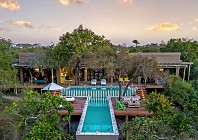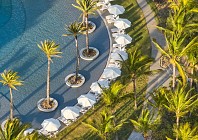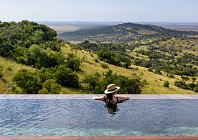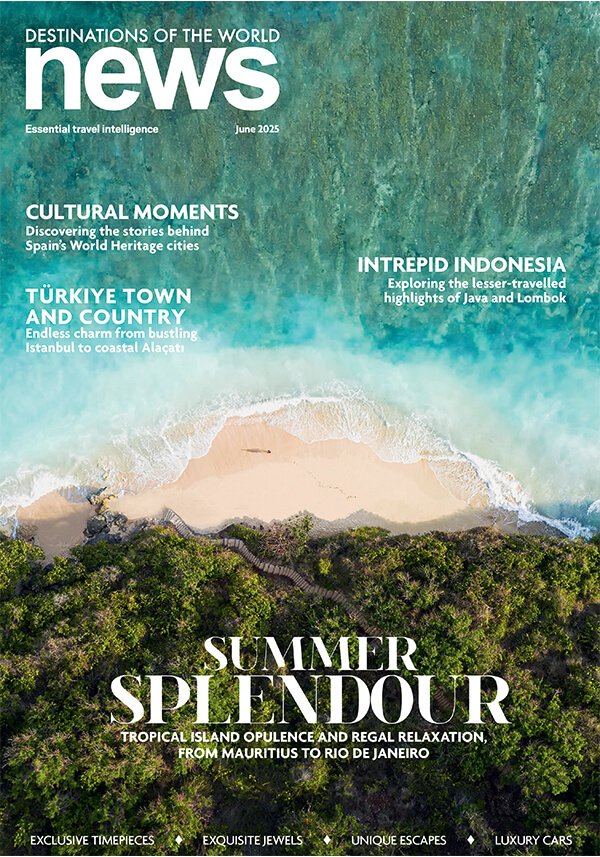It's little more than a shadow in the corner of my eye — a fleeting movement that doesn’t quite fit the knuckled, arid landscape of the sprawling Tsaris Mountains. Silhouetted against a sky of deepening orange, the gentle scuff of a hoof and a sharp, horse-like snort reveals what we have been searching for all day. In the maturing dusk stand five wild zebras — two adults, three foals.
Our mid-afternoon trek begins as an excursion to explore the thriving flora rooted in the harsh plains of southern Namibia, but quickly changes focus when the expert eyes of our guide, sharpened by years in the field, spots a small herd of zebras on the horizon. As the group scrambles for binoculars, squinting into the setting sun, we change route with renewed energy, spurred by grand ambitions of an up-close equine encounter.
Descending the winding mountain path, we navigate coarse, thorned bushels, rock-strewn walkways and past exulting quiver trees plucked straight from a Dr. Seuss novel. Beyond our immediate trail, brown plains and ridged peaks stretch as far as the eye can see, scarred by clumsy, man-made dirt roads. If there is one thing that truly inspires when visiting Namibia, it is this diverse natural landscape.
Neighbours South Africa, Botswana and Zambia might attract the lion’s share of attention when it comes to safari holidays, but the Kunene region of northern Namibia is the only location in the world that is home to native desert lions — the barren Skeleton Coast is where these predators prowl, and marks the point where rolling plains become ocean-meeting desert. In Namibia, an off-road adventure will see you travelling from sub-tropical woodland to mountainous escarpments and towering sand dunes in a matter of hours.
LODGE LIFE
As the sun ebbs, the zebras continue to distance themselves from us. We reluctantly heed the advice of our weathered guide and make our way back to the Zebra River Lodge. Sitting at the base of the valley, the lodge is quaint, intimate and dramatic. At full capacity it accommodates just 36 guests, all housed in traditional flat stone lodges. It is not often that a lack of TV and phone reception is welcome, but in this case, it is a blessing. In the fading light, nothing but the slow, rhythmic clink of the farm’s water pump can be heard.
Dinner is served on the veranda as our South African host and lodge-owner, Louis Fourie, recounts tales of lost bearings and leopard encounters in the calm tone of someone who is used to living in the wilderness. The worst incident, he says, was one in which a badly broken ankle required his trekking party to be airlifted from a steep mountainside. I suggest that maybe a change of career is in order. “This is Africa,” he replies. “Once you’re bitten by the bug, there’s no going back.”
As I ponder whether he means this literally, my eyes are drawn to the lodge’s nearby watering hole. No more than five metres away stand the elusive zebras. The adults cautiously survey the area and dip their heads to drink and the foals clumsily follow suit. The futile hours spent tracking these elegant creatures may have offered dramatic views, but nothing rivals seeing them eye to eye. As more animals emerge from the darkness to feed their thirst, a heaving oasis comes into focus.
Early the next morning we leave the lodge for a bumpy two-hour journey to Solitaire, a small settlement on the edge of the Namib-Naukluft National Park. This former farm ranch has a post office, bakery and petrol pump, making it the only public service station between the dunes of Sossusvlei in the southern Namib desert and the coastal city of Walvis Bay in the north. Aside from the occasional isolated farm, this is the only link to civilisation on a six-hour, 400-kilometre route.
The vast remoteness of Solitaire is palpable. Distant mountains shimmer in the heat and dry, yellowing plains stretch indefinitely. In many ways, this amplified nothingness is the country’s main attraction. For a landmass the size of France and Germany combined, Namibia boasts a minute population of just over 2.2 million. It’s capital, Windhoek, accounts for less than 15 percent of this total. Leave the cities and you’re more likely to bump into a galloping springbok than another human being, and that’s exactly why people come here.
SPOTTING CHEETAHS
Luckily, we are not in Solitaire to see people. We are here to see cheetahs. Adjacent to the settlement’s bakery sits the high-end Solitaire Guest Farm Desert Ranch, home to the Namib Carnivore Conservation Centre and its six semi-wild, ambassador cheetahs. I take a seat in one of the ranch’s rugged open-top off-roaders and absorb our guide’s advice. “You are not looking for the predators themselves,” she says. “You are looking for tiny movements that don’t fit the landscape, that’s what gives them away.”
Our full jeep shudders into the conservation area and its passengers erupt into muffled mutterings and excited gestures. Unsurprisingly, our novice observations fail to pinpoint a single animal. We turn, instead, to the much more reliable radio-collar tracking. Each of the six resident cheetahs in the Carnivore Conservation Centre has been fitted with a collar to help track their movements to educate rangers and visitors about cheetah behaviour. We soon find the animals sheltering from the relentless midday sun in the shade of a stubby bushel, lethargic and well-fed. In this condition, it is easy to forget the raw power and natural conditioning of these predators.
There are times, however, when feline reflexes twitch. In an instant, the cheetahs move from sedentary to alert, and with penetrating eyes fixed on the jeep, they carve a fluid path through the tall grass with slinking shoulder blades and bared teeth. In these moments, the true nature of African wilderness is revealed. We may be observing two males in a (semi-) controlled environment, but their instincts remain intact: kill or be killed. Namibia is home to the largest population of cheetahs in the world, with some 5,000 in the wild, a number it is working hard to stabilise and increase. But Namibia’s relationship with conservation is complex.
Today, communal conservancies, national parks and tourism concessions combine to protect over 40 percent of the country’s landmass, allowing visitors to safely observe everything from rare black rhinos to leopards and elephants. But this has been notoriously difficult to achieve.
Namibia, formerly South West Africa, was a German colony until 1918, when South Africa was mandated by the League of Nations to administer the territory on its own terms. South Africa applied the apartheid principle to the country, stripping indigenous people of their land and redistributing it among settler farmers forcing native Namibians to lead their livestock to the barren Kunene region, where competition for grazing with domestic wildlife was fierce.
When drought hit southern Africa in the 1980s, animal numbers started dropping. Rural Namibians were hunting to survive, and the South African National Defence Force continued hunting for profit, creating a wildlife crisis. After Namibian independence in 1990, the LIFE (Living in a Finite Environment) programme was introduced, bringing donor support from USAID and WWF. This created a system of community-based natural resource management, stabilising and even increasing the population of wild animals in Namibia.
This turbulent history generates mixed feelings as I arrive at my final destination: Kalakwa Aru Game Lodge. This trophy hunting property is in the Khomas region, just 90 minutes from Windhoek, and covers a combined area of over 56,000 hectares with its sister lodge, Veronica. I am greeted at the entrance by a glass of fresh fruit juice and a handshake from my host, Stephan Joubert. On the bumpy 10-kilometre drive from the gate to the farmhouse, he explains how hunting has become an integral part of wildlife maintenance in Namibia. Trophy hunting, he says, has boosted tourism while generating vital funds for conservation efforts.
ON THE HUNT
I ponder the irony of Namibia’s situation as we pull into the lodge. A cluster of six detached, wood-clad chlaets are set among arching trees, shrubs and sculpted gardens, enveloped by the mountainscape. My large double cabin has the welcoming aroma of fresh-cut wood, with views over the pool and outdoor barbecue area. Small touches, such as the complimentary wine and fresh thyme on the pillow, complete the homely feel. Kalakwa and Veronica are only ever occupied by one group at a time, so bonds quickly form between guest and host.
After an early evening game drive, I settle down to dinner with the lodge owners and a visiting German family. We enjoy tender Kudu steaks, freshly baked bread and aubergine tagine, prepared using vegetables grown in the property’s garden. I am not surprised to learn that the meat came fresh from the morning’s hunt; it is one of the best prime cuts I have ever tasted.
But there is more to this lodge than just hunting. Kalakwa’s private spa offers weary travellers a variety of stress-relieving treatments using luxurious Kalahari products. Those with adventurous spirits can head into the wilderness on horseback or quad bike, taking trails to valley floors and mountain peaks with stellar views.
I leave for the airport at sunrise the next morning, a time when animals are at their most active. In the early light, the eyes of fearless baboons reflect headlights, brawny wildebeest prance across the dirt road and a flamboyance of flamingos perch by a watering hole. On take-off, they all disappear into the arid landscape. As the aircraft gains height, I find myself wondering what else is out there, and how soon I can come back to see it.
THE GOLDEN BOOK
Zebra River Lodge
Tel: +264 63 693 265
www.zebra-river-lodge.com
Solitaire Guest Farm Desert Ranch
Tel: +264 61 305 173
www.solitaireguestfarm.com
Kalakwa Aru Game Lodge
Tel: +264 62 560 049
www.arugamelodge.com















